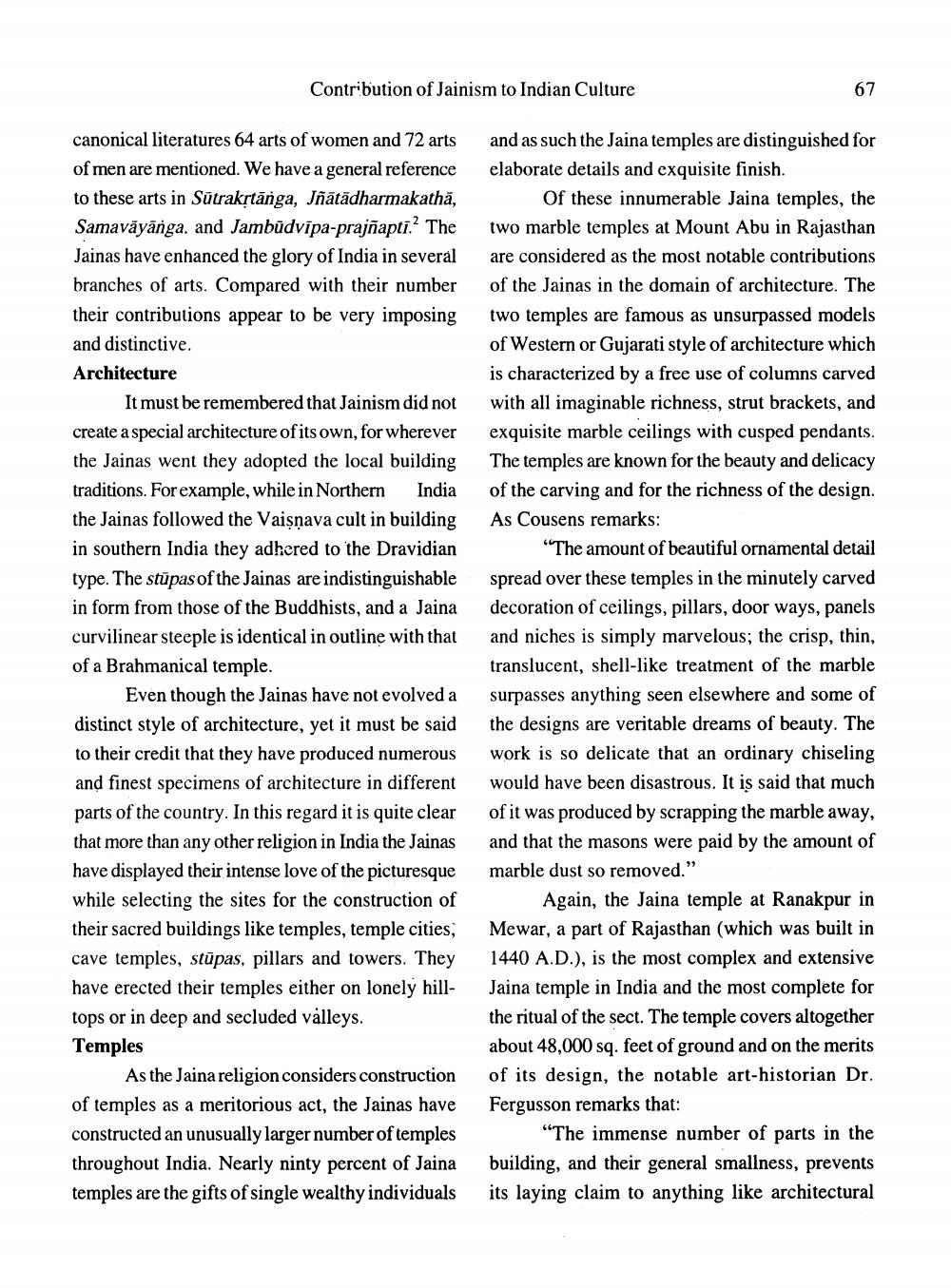________________
Contribution of Jainism to Indian Culture
canonical literatures 64 arts of women and 72 arts of men are mentioned. We have a general reference to these arts in Sūtrakṛtānga, Jñātādharmakathā, Samaväyänga, and Jambudvipa-prajñapti.? The Jainas have enhanced the glory of India in several branches of arts. Compared with their number their contributions appear to be very imposing and distinctive.
Architecture
It must be remembered that Jainism did not create a special architecture of its own, for wherever the Jainas went they adopted the local building traditions. For example, while in Northern India the Jainas followed the Vaisnava cult in building in southern India they adhered to the Dravidian type. The stūpas of the Jainas are indistinguishable in form from those of the Buddhists, and a Jaina curvilinear steeple is identical in outline with that of a Brahmanical temple.
Even though the Jainas have not evolved a distinct style of architecture, yet it must be said to their credit that they have produced numerous and finest specimens of architecture in different parts of the country. In this regard it is quite clear that more than any other religion in India the Jainas have displayed their intense love of the picturesque while selecting the sites for the construction of their sacred buildings like temples, temple cities, cave temples, stūpas, pillars and towers. They have erected their temples either on lonely hilltops or in deep and secluded valleys. Temples
As the Jaina religion considers construction of temples as a meritorious act, the Jainas have constructed an unusually larger number of temples throughout India. Nearly ninty percent of Jaina temples are the gifts of single wealthy individuals
67
and as such the Jaina temples are distinguished for elaborate details and exquisite finish.
Of these innumerable Jaina temples, the two marble temples at Mount Abu in Rajasthan are considered as the most notable contributions of the Jainas in the domain of architecture. The two temples are famous as unsurpassed models of Western or Gujarati style of architecture which is characterized by a free use of columns carved with all imaginable richness, strut brackets, and exquisite marble ceilings with cusped pendants. The temples are known for the beauty and delicacy of the carving and for the richness of the design. As Cousens remarks:
"The amount of beautiful ornamental detail spread over these temples in the minutely carved decoration of ceilings, pillars, door ways, panels and niches is simply marvelous; the crisp, thin, translucent, shell-like treatment of the marble surpasses anything seen elsewhere and some of the designs are veritable dreams of beauty. The work is so delicate that an ordinary chiseling would have been disastrous. It is said that much of it was produced by scrapping the marble away, and that the masons were paid by the amount of marble dust so removed."
Again, the Jaina temple at Ranakpur in Mewar, a part of Rajasthan (which was built in 1440 A.D.), is the most complex and extensive Jaina temple in India and the most complete for the ritual of the sect. The temple covers altogether about 48,000 sq. feet of ground and on the merits of its design, the notable art-historian Dr. Fergusson remarks that:
"The immense number of parts in the building, and their general smallness, prevents its laying claim to anything like architectural




